Effects of the Balance Hole Diameter on the Flow Characteristics of the Rear Chamber and the Disk Friction Loss in the Centrifugal Pump
Abstract
:1. Introduction
2. Research Object and Numerical Method
2.1. Research Object
2.2. Numerical Calculation Method
2.3. Computational Model Check
3. Calculation Results and Analysis
3.1. External Characteristics of Centrifugal Pump
3.2. Characteristics of Flow Field in the Rear Chamber
3.3. Tangential Velocity in the Rear Chamber
3.4. Radial Velocity in the Rear Chamber
3.5. Verification of the Flow Velocity in the Rear Chamber
3.6. Disk Friction Loss of Rear Chamber
4. Conclusions
Author Contributions
Funding
Institutional Review Board Statement
Informed Consent Statement
Data Availability Statement
Conflicts of Interest
References
- Tan, M.G.; Lu, Y.D.; Wu, X.F.; Liu, H.L.; Tian, X. Investigation on performance of a centrifugal pump with multi-malfunction. J. Low Freq. Noise Vib. Act. Control 2020, 40, 740–752. [Google Scholar] [CrossRef]
- Zhu, D.; Xiao, R.F.; Yao, Z.F.; Yang, W.; Liu, W.C. Optimization design for reducing the axial force of a vaned mixed-flow pump. Eng. Appl. Comput. Fluid Mech. 2020, 14, 882–896. [Google Scholar] [CrossRef]
- Wang, K.; Luo, G.Z.; Li, Y.; Xia, R.C.; Liu, H.L. Multi-condition optimization and experimental verification of impeller for a marine centrifugal pump. Int. J. Nav. Archit. Ocean Eng. 2020, 12, 71–84. [Google Scholar] [CrossRef]
- Cheng, X.R.; Chang, Z.B.; Jiang, Y.M. Study on the influence of the specific area of balance hole on cavitation performance of high-speed centrifugal pump. J. Mech. Sci. Technol. 2020, 34, 3325–3334. [Google Scholar] [CrossRef]
- Nishida, M.; Nakayama, K.; Sakota, D.; Kosaka, R.; Maruyama, O.; Hyakutake, T.; Kuwana, K.; Yamane, T. Properties of a monopivot centrifugal blood pump manufactured by 3D printing. J. Artif. Organs 2016, 19, 322–329. [Google Scholar] [CrossRef] [PubMed]
- Dong, W.; Chen, D.Y.; Sun, J.; Dong, Y.; Yang, Z.B.; Yan, J. Influence of balance hole diameter on leakage flow of the balance chamber in a centrifugal pump. Shock Vib. 2021, 2021, 8860493. [Google Scholar] [CrossRef]
- Cheng, X.R.; Luo, J.H.; Xiong, B.; Jiang, Y.M. Influence of the balance hole circumferential position on the cavitation performance of the semiopen impeller centrifugal pump. Math. Probl. Eng. 2021, 2021, 4472433. [Google Scholar] [CrossRef]
- Wu, Y.; Chen, X.P.; Dou, H.S.; Zheng, L.L.; Zhu, Z.C.; Cui, B.L.; Khoo, B.C. Numerical simulation and analysis of flow characteristics in the front chamber of a centrifugal pump. J. Mech. Sci. Technol. 2017, 31, 5131–5140. [Google Scholar] [CrossRef]
- Chao, Q.; Zhang, J.H.; Zhai, J. Effects of inclined cylinder ports on gaseous cavitation of high-speed electro-hydrostatic actuator pumps: A numerical study. Eng. Appl. Comput. Fluid Mech. 2019, 13, 245–253. [Google Scholar] [CrossRef] [Green Version]
- Zhang, N.; Liu, X.K.; Gao, B.; Xia, B. DDES analysis of the unsteady wake flow and its evolution of a centrifugal pump. Renew. Energy 2019, 141, 570–582. [Google Scholar] [CrossRef]
- Olimstad, G.; Osvoll, M.; Finstad, P.H.E. Very low specific speed centrifugal pump-hydraulic design and physical limitations. J. Fluids Eng. 2018, 140, 071403. [Google Scholar] [CrossRef]
- Will, B.C.; Benra, F.K.; Dohmen, H.J. Investigation of the flow in the impeller side clearances of a centrifugal pump with volute casing. J. Therm. Sci. 2012, 21, 197–208. [Google Scholar] [CrossRef]
- Salvadori, S.; Marini, A.; Martelli, F. Methodology for the residual axial thrust evaluation in multistage centrifugal pumps. Eng. Appl. Comput. Fluid Mech. 2012, 6, 271–284. [Google Scholar] [CrossRef] [Green Version]
- Lefor, D.; Kowalski, J.; Kutschelis, B.; Herbers, T.; Mailach, R. Optimization of axial thrust balancing swirl breakers in a centrifugal pump using stochastic methods. In Proceedings of the ASME 2014 4th Joint US-European Fluid Engineering Division Summer Meeting, Chicago, IL, USA, 3–7 August 2014. FEDSM2014-21262. [Google Scholar]
- Ladouani, A.; Nemdili, A. Influence of reynolds number on net positive suction head of centrifugal pumps in relation to disc friction losses. Forsch. Ing. 2009, 73, 173–182. [Google Scholar] [CrossRef]
- Wang, C.; Shi, W.D.; Wang, X.K.; Jiang, X.P.; Yang, Y.; Li, W.; Zhou, L. Optimal design of multistage centrifugal pump based on the combined energy loss model and computational fluid dynamics. Appl. Energy 2017, 187, 10–26. [Google Scholar] [CrossRef]
- Barrio, R.; Parrondo, J.; Blanco, E. Numerical analysis of the unsteady flow in the near-tongue region in a volute-type centrifugal pump for different operating points. Comput. Fluids 2010, 39, 859–870. [Google Scholar] [CrossRef]
- Kim, E.; Palazzolo, A. Rotordynamic force prediction of a shrouded centrifugal pump impeller-part I: Numerical analysis. J. Vib. Acoust. 2016, 138, 031014. [Google Scholar] [CrossRef]
- Huang, B.; Zeng, G.T.; Qian, B.; Wu, P.; Shi, P.L.; Qian, D.Q. Pressure fluctuation reduction of a centrifugal pump by blade trailing edge modification. Processes 2021, 9, 1408. [Google Scholar] [CrossRef]
- Sojoudi, A.; Nourbakhsh, A.; Shokouhmand, H. Establishing a relationship between hydraulic efficiency and temperature rise in centrifugal pumps: Experimental study. J. Hydraul. Eng. 2018, 144, 04018011. [Google Scholar] [CrossRef]
- Li, W.; Jiang, X.P.; Pang, Q.L.; Zhou, L.; Wang, W. Numerical simulation and performance analysis of a four-stage centrifugal pump. Adv. Mech. Eng. 2016, 8, 1687814016673756. [Google Scholar] [CrossRef] [Green Version]
- Li, Y.B.; He, C.H.; Li, J.Z. Study on flow characteristics in volute of centrifugal pump based on dynamic mode decomposition. Math. Probl. Eng. 2019, 2019, 2567659. [Google Scholar] [CrossRef]
- Liu, H.L.; Liu, M.M.; Bai, Y.; Dong, L. Effects of mesh style and grid convergence on numerical simulation accuracy of centrifugal pump. J. Cent. South Univ. 2015, 22, 368–376. [Google Scholar] [CrossRef]
- Casimir, N.; Zhu, X.Y.; Hundshagen, M.; Ludwig, G.; Skoda, R. Numerical study of rotor-stator interaction of a centrifugal pump at part load with special emphasis on unsteady blade load. J. Fluids Eng. 2020, 142, 081203. [Google Scholar] [CrossRef]
- Dong, W.; Chu, W.L. Numerical investigation of fluid flow mechanism in the back shroud cavity of a centrifugal pump. J. Appl. Fluid Mech. 2018, 11, 709–719. [Google Scholar] [CrossRef]
- Fu, Y.X.; Yuan, J.P.; Yuan, S.Q.; Pace, G.; d’Agostino, L.; Huang, P.; Li, X.J. Numerical and experimental analysis of flow phenomena in a centrifugal pump operating under low flow rates. J. Fluids Eng. 2014, 137, 011102. [Google Scholar] [CrossRef]
- Seelig, T.; Harlander, U.; Gellert, M. Experimental investigation of stratorotational instability using a thermally stratified system: Instability, waves and associated momentum flux. Geophys. Astrophys. Fluid Dyn. 2018, 112, 239–264. [Google Scholar] [CrossRef]

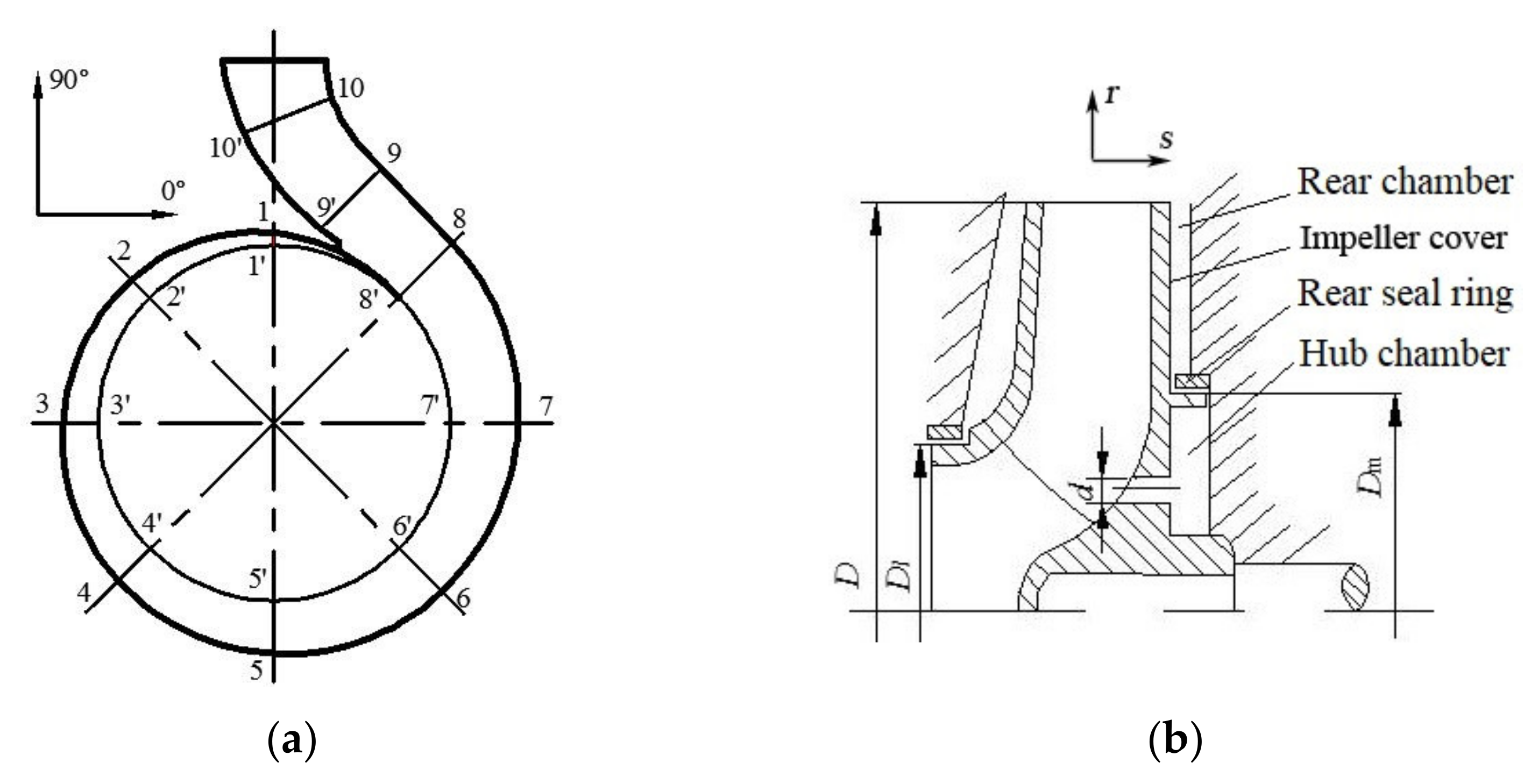
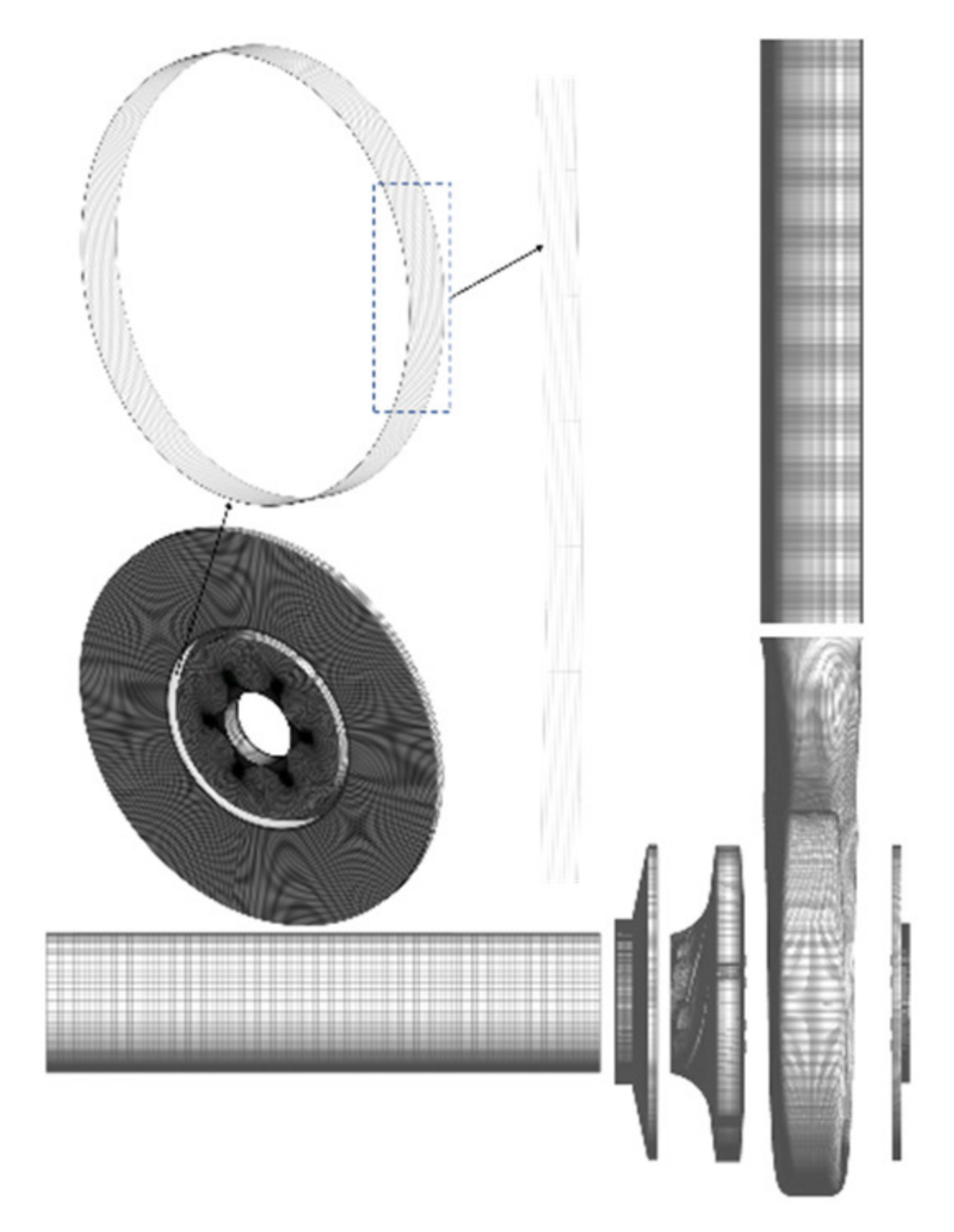
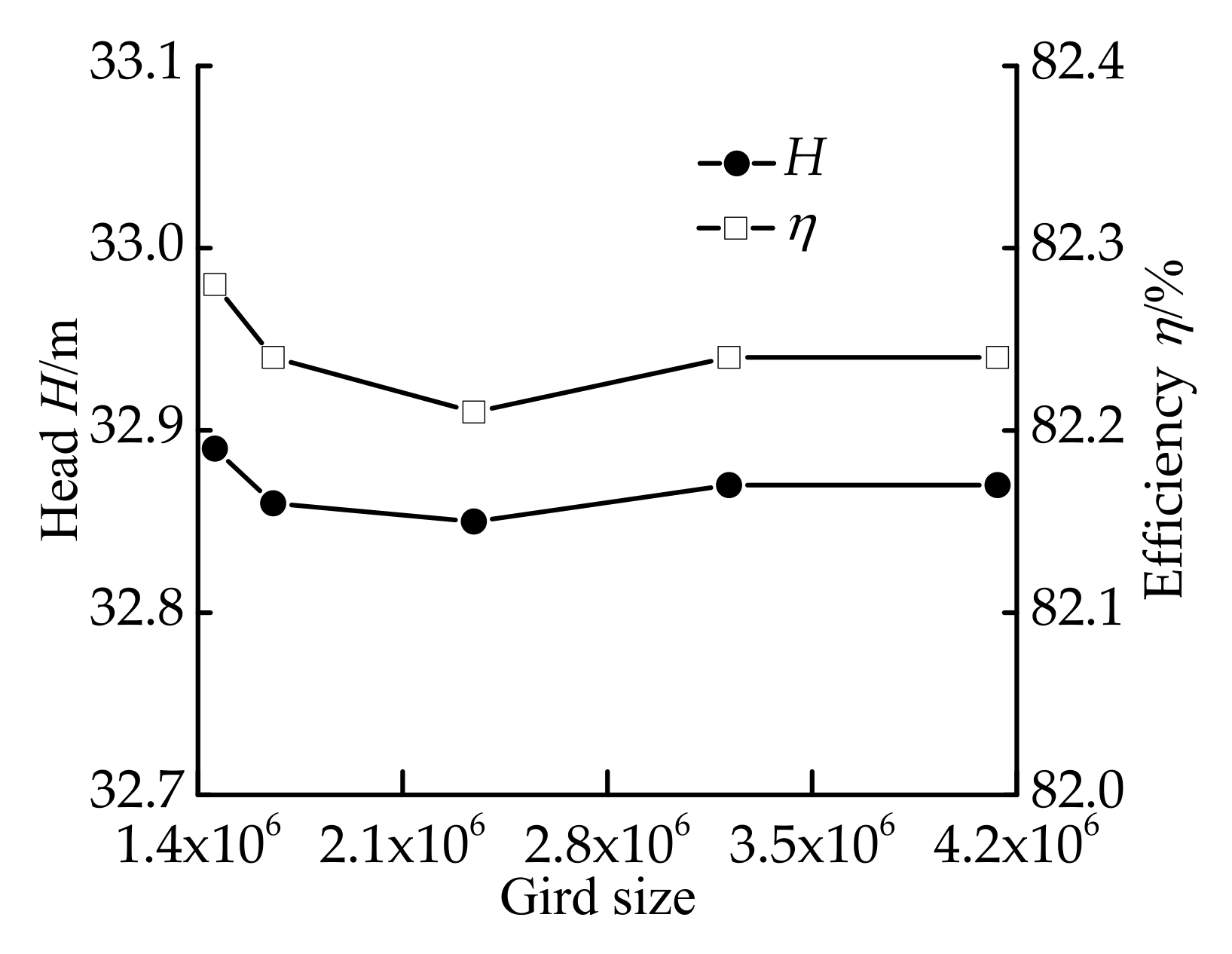
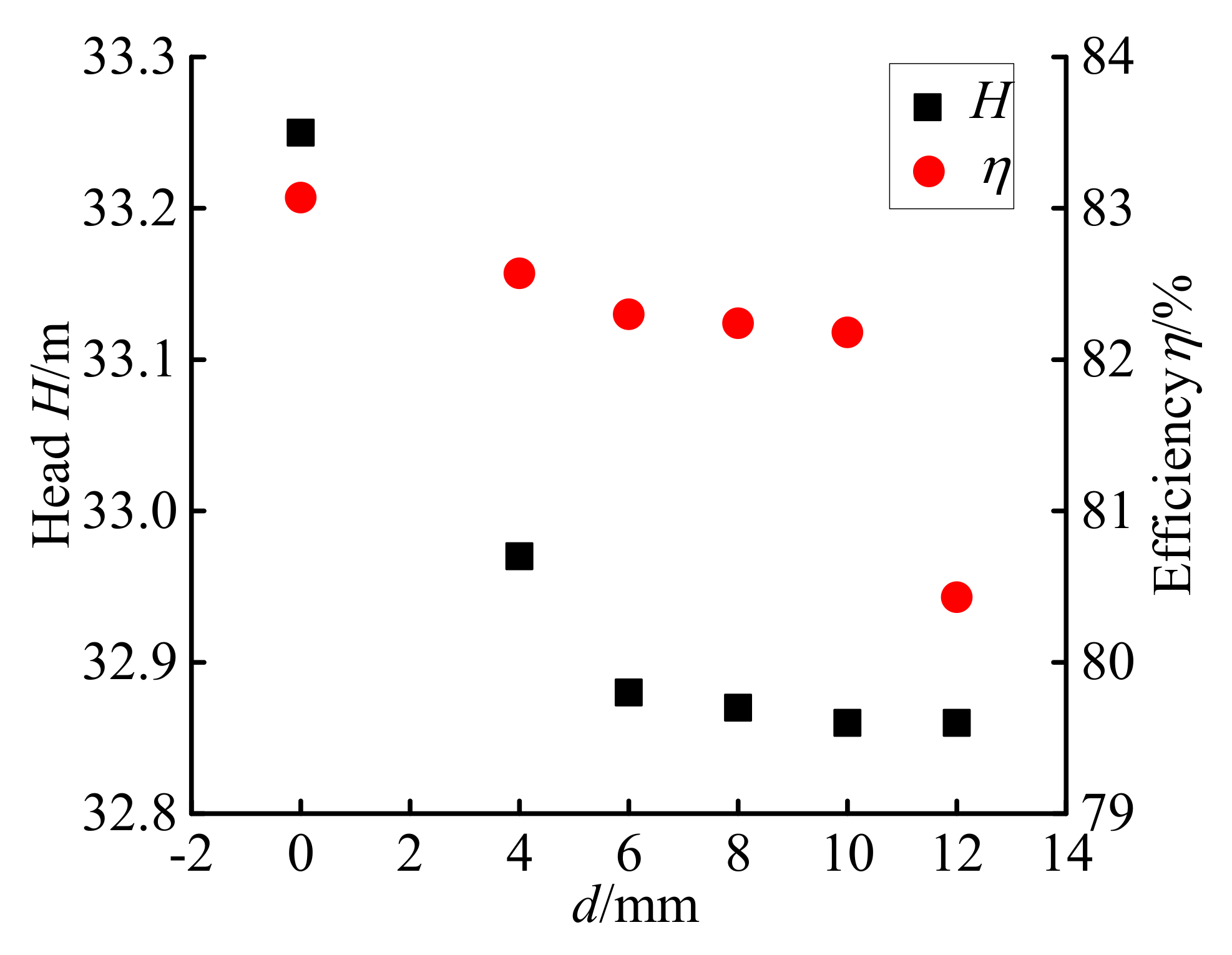
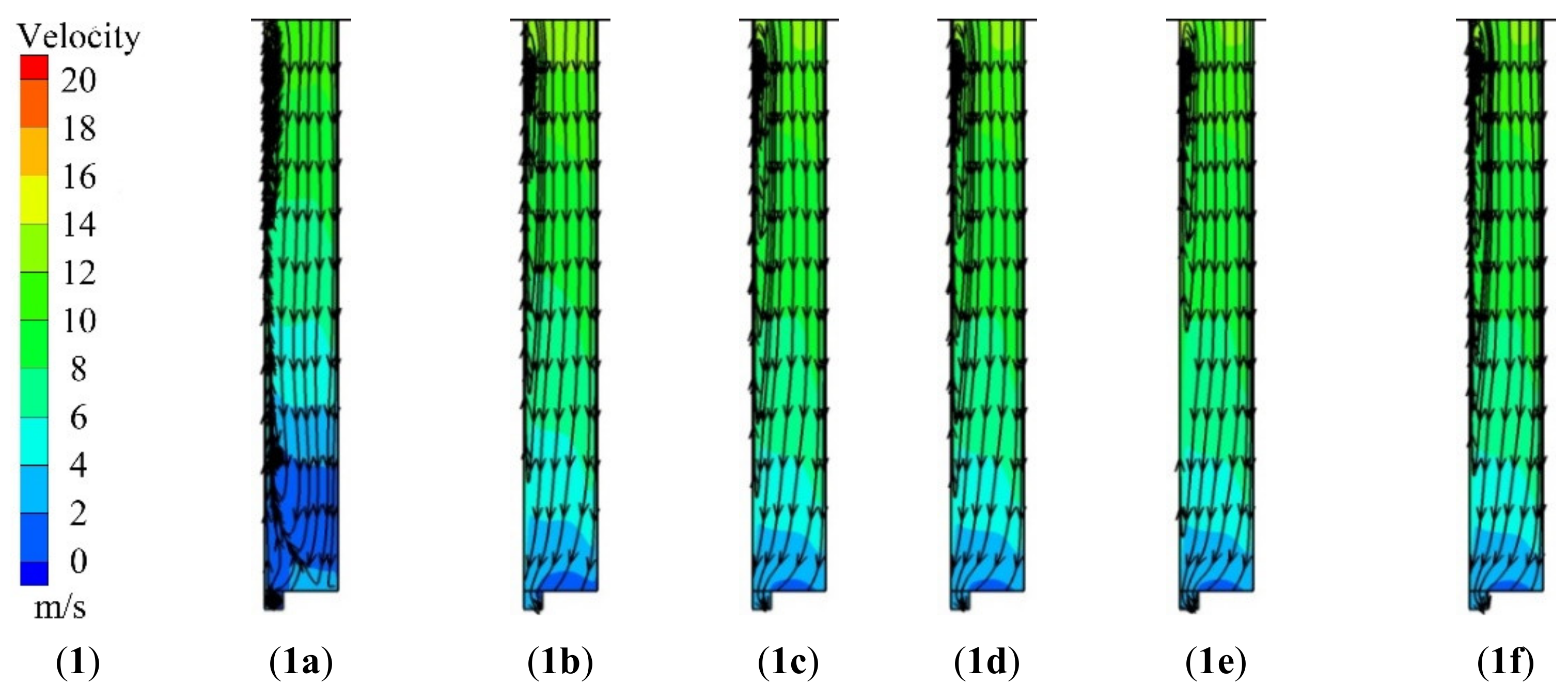
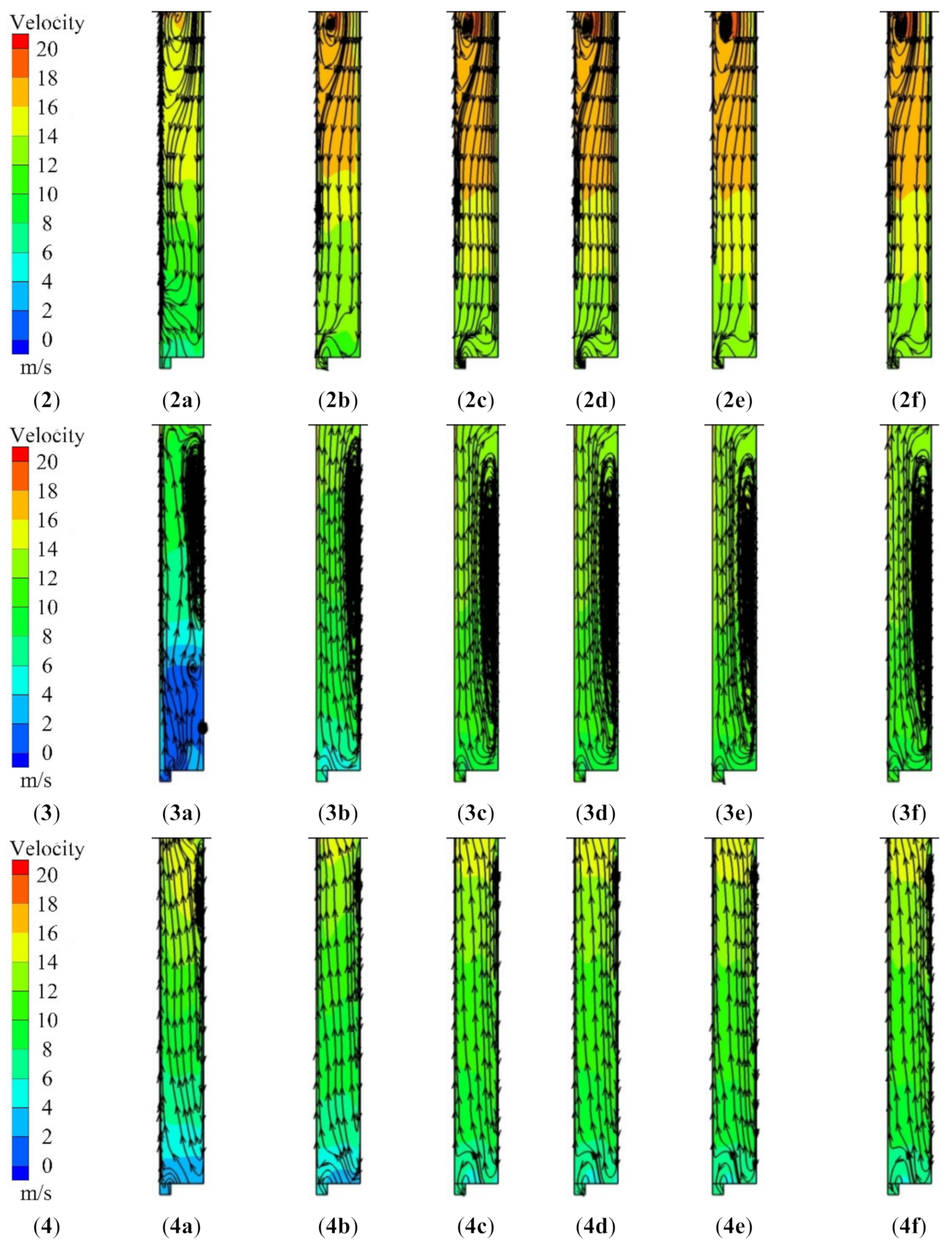
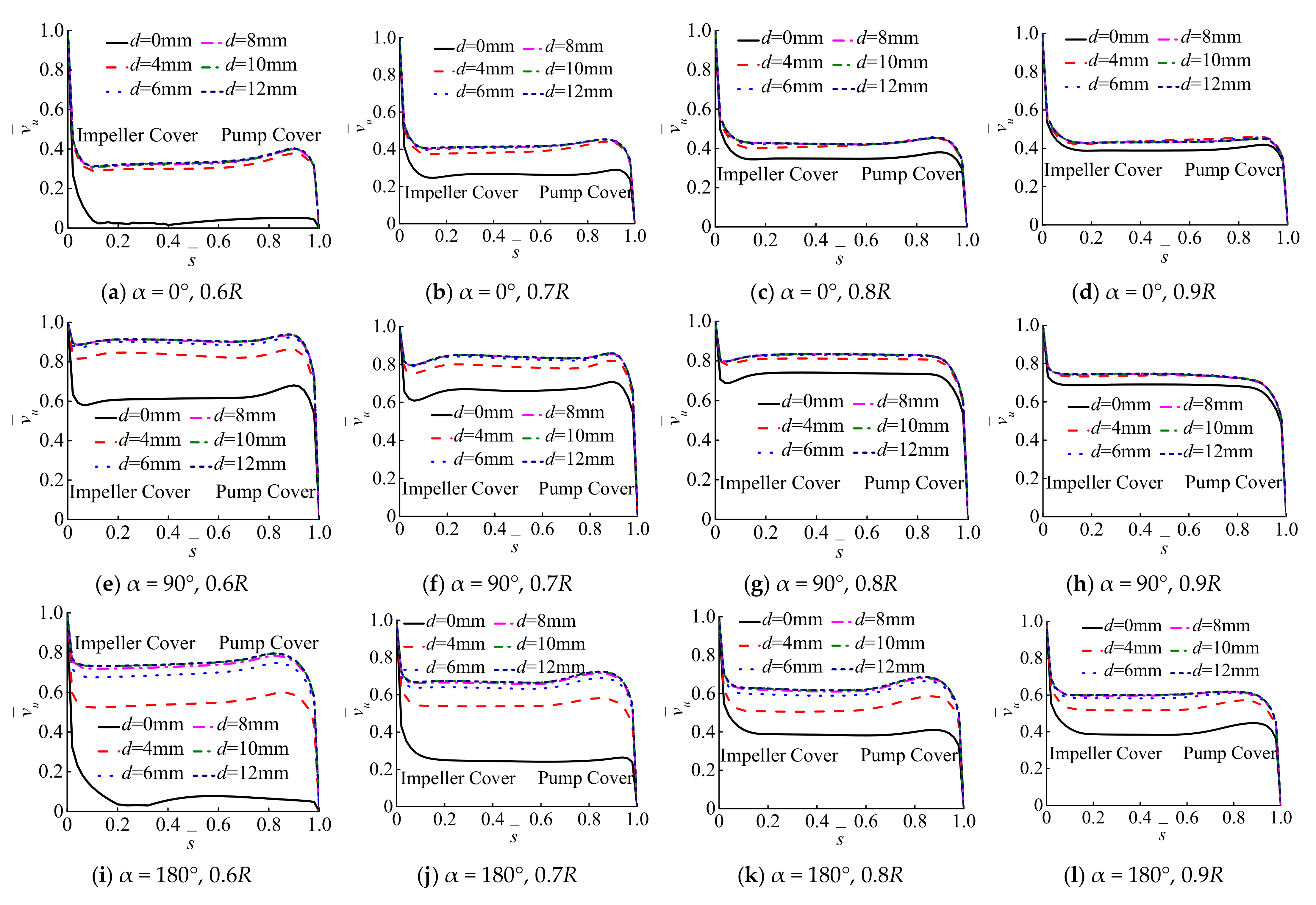

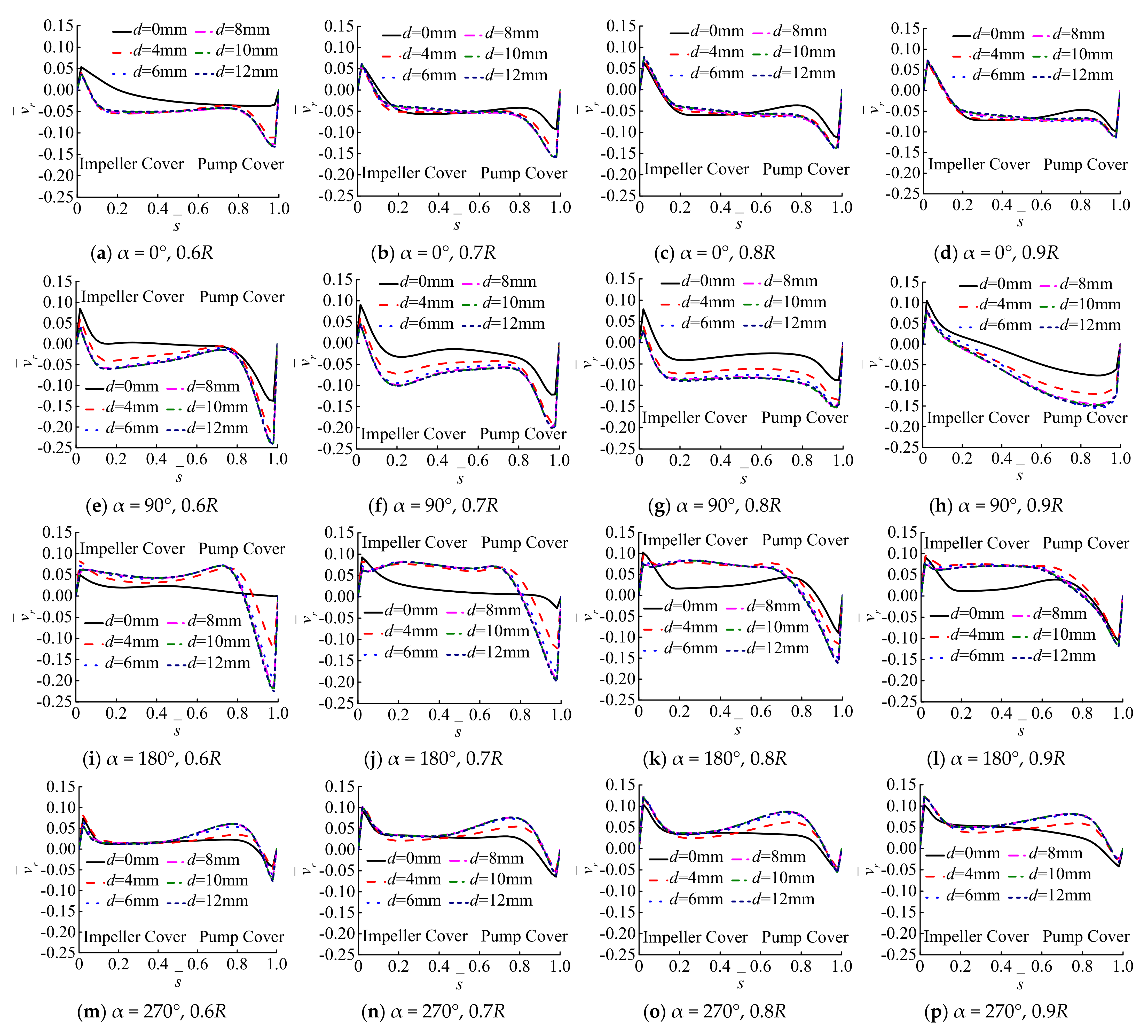

| Description | Parameter | Value |
|---|---|---|
| Design flow rate (m3/h) | Qd | 200 |
| Head (m) | H | 32 |
| Efficiency (%) | ƞ | 81 |
| Rotating speed (r/min) | n | 1450 |
| Specific speed | ns | 87 |
| Shroud diameter (mm) | D | 325 |
| Front sealing ring diameter (mm) | Dl | 140 |
| Back sealing ring diameter (mm) | Dm | 165 |
| Sealing ring radial clearance (mm) | b | 0.22 |
| Balance hole diameter (mm) | d | 8 |
| Balance holes number | z1 | 6 |
| Blade number | z2 | 6 |
| d/(mm) | 0 | 4 | 6 | 8 | 10 | 12 |
| vu1/(m/s) | 6.328 | 7.050 | 10.510 | 11.338 | 10.837 | 11.259 |
| P1/(kW) | 4.455 | 3.946 | 1.935 | 1.559 | 1.756 | 1.593 |
Publisher’s Note: MDPI stays neutral with regard to jurisdictional claims in published maps and institutional affiliations. |
© 2022 by the authors. Licensee MDPI, Basel, Switzerland. This article is an open access article distributed under the terms and conditions of the Creative Commons Attribution (CC BY) license (https://creativecommons.org/licenses/by/4.0/).
Share and Cite
Dong, W.; Liu, Z.; Zhang, H.; Zhang, G.; Jiang, H.; Li, P. Effects of the Balance Hole Diameter on the Flow Characteristics of the Rear Chamber and the Disk Friction Loss in the Centrifugal Pump. Processes 2022, 10, 613. https://doi.org/10.3390/pr10030613
Dong W, Liu Z, Zhang H, Zhang G, Jiang H, Li P. Effects of the Balance Hole Diameter on the Flow Characteristics of the Rear Chamber and the Disk Friction Loss in the Centrifugal Pump. Processes. 2022; 10(3):613. https://doi.org/10.3390/pr10030613
Chicago/Turabian StyleDong, Wei, Ze Liu, Haichen Zhang, Guang Zhang, Haoqing Jiang, and Peixuan Li. 2022. "Effects of the Balance Hole Diameter on the Flow Characteristics of the Rear Chamber and the Disk Friction Loss in the Centrifugal Pump" Processes 10, no. 3: 613. https://doi.org/10.3390/pr10030613
APA StyleDong, W., Liu, Z., Zhang, H., Zhang, G., Jiang, H., & Li, P. (2022). Effects of the Balance Hole Diameter on the Flow Characteristics of the Rear Chamber and the Disk Friction Loss in the Centrifugal Pump. Processes, 10(3), 613. https://doi.org/10.3390/pr10030613








